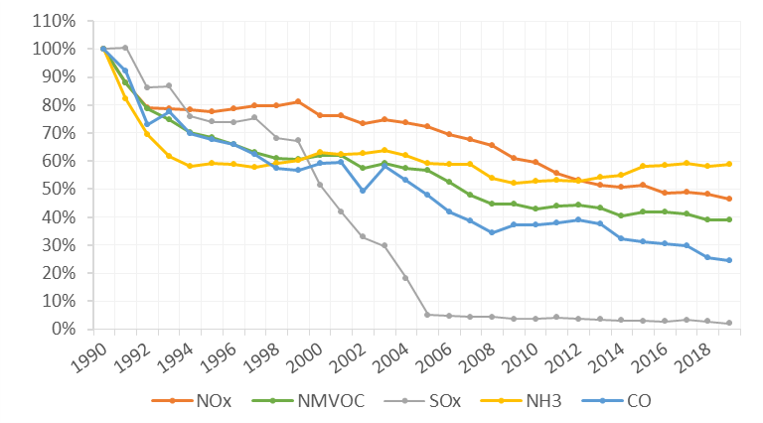Main air pollutant materials
Figure 1. presents the time-series of the main air pollutants, showing their percentage change compared to the level of the base year (1990). By 2019, for all five pollutants, emissions fell to less than 60% of their 1990 levels. Hungary achieved the most significant results in the case of sulphur oxides (SOx), but also in the emissions of nitrogen oxides (NOx), non-methane volatile organic compounds (NMVOCs) and carbon monoxide (CO), 47%, 39%, and 25% decrease can be observed, respectively. Ammonia (NH3) emissions have not shown a definite declining trend since the decrease at the beginning of the time-series, and even an increase can be observed in recent years.

Figure 1. Trend in the emissions of main pollutants between 1990 and 2019
The term 'nitrogen oxides' is usually used to include two gases: nitric oxide (NO), which is a colourless, odourless gas and nitrogen dioxide (NO2), which is a reddish-brown gas with a pungent odour. Nitric oxide reacts with oxygen or ozone in the air to form nitrogen dioxide. These gases form when fuel is burned at high temperatures. NOx pollution is emitted by automobiles, trucks and various non-road vehicles (e.g., construction equipment, boats, etc.) as well as industrial sources such as power plants, industrial boilers, cement kilns, and turbines.
NMVOCs are all organic carbon compounds other than methane that react with nitrogen oxides and participate in atmospheric photochemical processes when exposed to sunlight. Among the hundreds of such compounds, the simplest ones are, e.g. the benzene, xylene, propane, butene, etc. In 2019, residential heating, cattle breeding, and the use of other NMVOC-containing products (e.g. household solvents, industrial and residential use of paints, food and beverage production, pharmaceuticals and other chemical products) were responsible for NMVOC emissions. In 2019, emissions from transport and transportation add only 11% to the national amount, despite the fact that emissions from them were the most significant source in the early 1990s with a share of around 40%. Industrial emissions have been relatively stable throughout the time-series.
Gaseous ammonia is the most abundant alkaline gas in the atmosphere. A stable binary hydride, ammonia is a colourless gas with a distinct characteristic of a pungent smell. Exposure to high concentrations of ammonia in air causes immediate burning of the eyes, nose, throat and respiratory tract and can result in blindness, lung damage or death. Inhalation of lower concentrations can cause coughing, and nose and throat irritation. The largest source of NH3 emissions is agriculture, including animal husbandry and NH3-based fertilizer applications. Other sources of ammonia include industrial processes, vehicular emissions and volatilization from soils and oceans. Agriculture is the main source of NH3 emissions, with 92% share of the national total in 2019. Manure management accounts for the bulk of national total ammonia emissions in Hungary, it was responsible for 45%. Fertilizer use at 26.5% are the second largest contributor to the national total ammonia emissions. Agricultural NH3 emissions have decreased by 41.3% since 1990. The main drivers of this reduction are the significant decrease in the emissions form swine and cattle, due to the dramatic drop in livestock numbers. Focusing on the period between 2005 and 2019 NH3 emissions from the agricultural sector have also decreased due to the further shrinking animal livestock. However, in the last years a slight increase in the emissions has been detectable due to the increasing fertilizer use and Cattle livestock.
Sulphur oxides (SOx) are compounds of sulphur and oxygen molecules. Sulphur dioxide (SO2) is the pre- dominant form found in the lower atmosphere. It is a colorless gas that can be detected by taste and smell in the range of 1,000 to 3,000 micrograms per cubic meter. When coal and oil burn, the sulphur in them combines with oxygen in the air to make sulphur oxides. Processing mineral ores that contain sulphur and industrial burning of fossil fuels are also sources of sulphur oxides in the atmosphere. The trend for sulphur oxides between 1998 and 2004 was characterized by a steady and large-scale decline due to investments to reduce emissions. In addition to the regime-change in 1989, by waste gas desulphurization and fuel changing in big industrial processes, one of the major environmental problems of the 1980s, the destructive effect of acid rains, was reduced. In 2019, the Hungarian SOx emission was only 18 kt, 2% of the amount emitted in 1990. In 2019, the energy industry played a leading role with 40% of total emissions, including electricity and heat generation, followed by residential fuel consumption with 35%, and the chemical industry with 19%.
Carbon monoxide (CO) is a colorless, odourless, tasteless, and toxic air pollutant. Breathing CO at high concentrations leads to reduced oxygen transport by hemoglobin, which has health effects that include impaired reaction timing, headaches, lightheadedness, nausea, vomiting, weakness, clouding of consciousness, coma, and, at high enough concentrations and long enough exposure, death. Carbon monoxide is produced in the incomplete combustion of carbon-containing fuels, such as gasoline, natural gas, oil, coal, and wood. Residential fuel consumption plays a leading role in carbon monoxide emissions. In 2019, this sector contributed to 63% of carbon monoxide emissions in Hungary. This was not always the case, from the 1990s to 2008. the main source of CO emissions was transport (during this period the share of carbon monoxide emitted during transport fluctuated between 39 and 59%). By 2019, the annual CO emissions in Hungary were 354 kt, which is a 76% decrease compared to the 1990 emissions.




